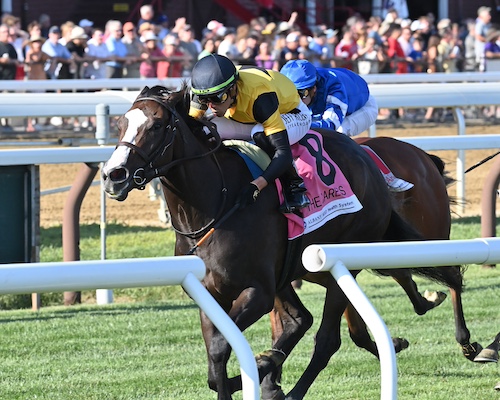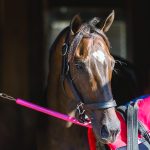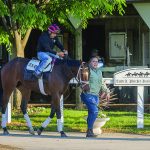By Joe Clancy
The Great Tomato Derby of 2010 went like this: One gardener grew a 6-foot plant (with one tomato); another raised a 40-tomato plant; someone else put his plant in a bucket. They overcame blight, insects, weeds, water, sun, earth, some jealousy, a little conflict, confusion and at least two fatalities (mowers).
Like any good Derby there was, of course, a winner.
Racetrack Chaplaincy volunteer Mike DeSano coordinated the backstretch tomato contest. He gave 30 seedlings in Solo cups to backstretch workers, who were charged with producing the best tomato plant during the Saratoga season. It’s too early to tell who has the best tomato – most aren’t ripe yet – but the plants were great.
DeSano’s been telling us all meet about the contest and finally wrangled me to find some time to be a judge. San Gennaro Day, it had to be San Gennaro Day (Aug. 26 to the non-Italian readers). OTB Channel host Jeanne Wood, Saratoga racetrack chaplain Humberto Chavez and I did the honors – inspecting the plants on a golf-cart tour that covered nearly every corner of the backstretch.
We started at Greentree, where Octavio Urista produced the tallest tomato plant I’ve ever seen – perhaps the world has ever seen. The 6-footer stands against a bunkhouse on the Greentree property in a small garden with other vegetables tended by Hugo Sanchez among others. The staff puts the garden to good use as the smell of lunch wafted off the front porch. Somewhere John Gaver is smiling. Urista’s giant plant apparently spent its time growing tall – only – as it yielded just one tomato.
Close, but no ketchup.
Next came the bucket. A full 46 inches high, the plant looked well on its way to producing a nice crop with four green tomatoes in work and a few buds on the way. Walter Ramos grew the plant outside a bunkhouse near Dale Romans’ barn on the main track side. Thinking versatility, Ramos put the plant in an Uptite Poultice bucket so he could move it from sun to shade depending on the weather. He might also be able to take it back to Belmont, or wherever the next stop is.
Nice work, but not quite pizza sauce.
On we drove to the Oklahoma side, where Ruffino Garcia cultivated a tomato plant Ragu would be proud of – small, dense, bushy even, and full of tomatoes. Dozens of plump, green tomatoes waiting to be picked once they turn red. The plant, built up on a bank of earth to help control the water and traffic, sits next to Building 90, just off the inside rail of the old Horse Haven track. Garcia works for Tony Dutrow and they will be having salsa soon.
The leader, but the sauce isn’t done yet.
On we drove to the Annex, where the most enthusiastic crew awaited. The Kiaran McLaughlin Tomato Team – led by Juan Jose Estrado (a.k.a. “El Payo”) – grew a 53-inch plan with a dozen tomatoes. The plant thrives next to dormitory building 123, and judging from the response of the team, gets lots of care. “Tomatoes the size of melons,” said one caretaker.
Another strong plant, but don’t call Campbell’s.
The massive garden at trainer Bruce Levine’s barn on the Oklahoma side came next. Somewhere in the midst of a huge plant is the one DeSano gave to Alejandro Rodriguez. The man with the “pulgar verde” has outdone himself with a small field of squash, tomatoes, mint and peppers of all varieties. The tomato plant got big, and wound up on the ground when the stakes wouldn’t hold, but that didn’t stop the tomatoes.
“If this was Macy’s that thing would be a float,” said photographer Maggie Kimmitt.
Nicely done, but the judges must discuss over a V-8.
First place, after much deliberation, went to Garcia – Tony Dutrow’s groom with the bushy model in Horse Haven. He won a $100 prize, a tomato from DeSano and backstretch bragging rights. Second place went to the McLaughlin team at the Annex, followed by the bucket plant, the Levine garden and the “Jack and the Beanstalk” at Greentree.
– – –
Beyond the tomatoes, the day was a reminder of the backstretch community. The track is a home to more than horses. People live here. They work, they play, they grow tomatoes, they cook, they tend a community garden, they play soccer, they talk to Chavez about everything – and Chavez talks back. The chaplain and DeSano – “Uncle Mike” to everyone he came across on our jaunt – work hard and put the people first. A tomato contest sounds goofy, but it worked.
“You could tell people had fun with it and took pride in it,” said Chavez. “The gardening makes for good food and saves money. Some of them did it in their countries so it’s a reminder of home.”








